Panama–Pacific International Exposition
The Panama–Pacific International Exposition was a world's fair held in San Francisco, California, United States, from February 20 to December 4, 1915. Its stated purpose was to celebrate the completion of the Panama Canal, but it was widely seen in the city as an opportunity to showcase its recovery from the 1906 earthquake. The fair was constructed on a 636 acre (1 sq. mi., 2.6 km2) site along the northern shore, between the Presidio and Fort Mason, now known as the Marina District.
| 1915 San Francisco | |
|---|---|
 Poster for the exhibition | |
| Overview | |
| BIE-class | Universal exposition |
| Category | Historical Expo |
| Name | Panama-Pacific International Exposition |
| Area | 636 acres (257 hectares) |
| Visitors | 18,876,438 |
| Organized by | Charles C. Moore |
| Participant(s) | |
| Countries | 24 |
| Location | |
| Country | United States |
| City | San Francisco |
| Venue | Marina District |
| Coordinates | 37°48′16.8″N 122°26′48″W |
| Timeline | |
| Opening | February 20, 1915 |
| Closure | December 4, 1915 |
| Universal expositions | |
| Previous | Exposition universelle et internationale (1913) in Ghent |
| Next | Independence Centenary International Exposition in Rio de Janeiro |
| Simultaneous | |
| Other | Panama–California Exposition |
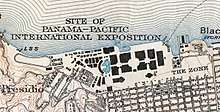
Exhibits
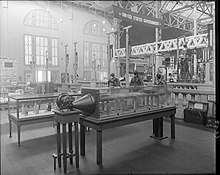
Among the exhibits at the Exposition was the C. P. Huntington, the first steam locomotive purchased by Southern Pacific Railroad; the locomotive then went on static display at the California State Railroad Museum in Sacramento. A telephone line was also established to New York City so people across the continent could hear the Pacific Ocean. The Liberty Bell traveled by train on a nationwide tour from Philadelphia, Pennsylvania, to attend the exposition.[1]
The 1915 American Grand Prize and Vanderbilt Cup auto races were held February 27 and March 6 on a 3.84-mile (6.18 km) circuit set up around the Exposition grounds.[2] The Smithsonian Institution also had an exhibition at the Exposition.[3]
Yumian (traditional Chinese: 魚麵; simplified Chinese: 鱼面), meaning fish-noodle in Chinese, is a noodle made with flour and fish from the Fushui River in Yunmeng, Hubei, China. Yunmeng Yumian was awarded silver medal of the Panama–Pacific International Exposition.[4][5]
Indigenous representation
Indian culture was a topic of interest during the nine-month-long exposition with multiple attractions dedicated to Indian life. The most popular attraction at the exposition that depicted Indian life is James Earle Fraser's statue, The End of the Trail.[6] Fraser's statue, which showed a Native American man slumped over on a horse, reflected the American idea at the time, that the Native American race was doomed for extinction. The exposition not only celebrated the completion of the Panama Canal, but also advances made by the American people, part of which were the conquests of indigenous people by Americans as well as Europeans.[7][8] These celebrations over the Native community, can be seen through artworks such as The End of the Trail and The Pioneer or tributes to Francisco Pizarro and Hernán Cortés.[9] In comparison to previous world fairs, the Panama–Pacific International Exposition showcased Indians more as nobles rather than savage people, but who were still inevitably destined to become extinct. These ideas were presented in plays, known as pageants, where Native Americans played small roles such as in “Catalonian dragoons, muleteers, and a tribe of Carmel Indians.”[10] While the demise of Native American people was a rhetoric created by fair organizers,scholars have argued that in reality, the Native persona was very present and did not reflect the idea that it was a disappearing civilization. Indians were in fact part of the fair, but attended as visitors, performers, and workers.[11] More recently, scholars have focused on Native representation in San Francisco's 1915 rival world fair, San Diego's 1915 Panama-California Exposition that showed Indian life in a more anthropological light versus this American ideal.[12]
Women and gender roles
During the Panama–Pacific International Exposition women were in charge of their own board known as the Woman's Board of San Francisco's Panama–Pacific International Exposition.[13] The board, also called the Boards of Lady Managers, allowed women to take part in organizing different aspects of the fair and more importantly gave them the opportunity to have a campaigning platform for discussing women's rights and social issues. It was commonly argued that the fair celebrated male dominance over women by not providing a building for women.[14] Also, men and women were depicted differently in artworks advertising the exposition. White women, specifically were presented as caretakers while men as strong and powerful saviors such as, in the poster “13thLabor of Hercules.” At the time, there was an idea of a “New Woman” who was more progressive and advance intellectually as well as sexually.[15] This idea of a “New Woman” related to the overarching theme of the fair, modernity and progress. In efforts to promote the fair and safety of the city, fair organizers used the “New Woman” as an advertising tactic and proof that San Francisco was an evolving and safe environment for tourists.[16] During the fair, women could be seen posing with agriculture from around the state in celebration of California's produce. All the women were young-beautiful white women who were often the highlight of many newspaper articles and events. This use of women, presented the idea that they were only useful for their beauty but failed to appreciate their intellectual capacity and physical abilities. One of the most memorable achievements of the Women's Board was the installment of statue that celebrated women, specifically mothers known as the Pioneer Mother.[17][18][19]
Architecture
The centerpiece was the Tower of Jewels, which rose to 435 feet and was covered with over 100,000 cut glass Novagems. The 3⁄4 to 2 inch colored "gems" sparkled in sunlight throughout the day and were illuminated by over 50 powerful electrical searchlights at night.
In front of the Tower, the Fountain of Energy flowed at the center of the South Gardens, flanked by the Palace of Horticulture on the west and the Festival Hall to the east. The arch of the Tower served as the gateway to the Court of the Universe, leading to the Court of the Four Seasons to the west and the Court of Abundance to the east. These courts formed the primary exhibit area for the fair, which included the Food Products Palace, the Education and Social Economy Palace, the Agriculture Palace, the Liberal Arts Palace, the Transportation Palace, the Manufacturers Palace, the Mines and Metallurgy Palace, and the Varied Industries Palace. The Machinery Palace, the largest hall, dominated the east end of the central court.
At the west end of central court group was the Palace of Fine Arts. Further west toward the bay down The Avenue of the Nations were national and states' buildings, displaying customs and products unique to the area represented. At the opposite end of the Fair, near Fort Mason was "The Zone", an avenue of popular amusements and concessions stands.
Construction
Constructed from temporary materials (primarily staff, a combination of plaster and burlap fiber), almost all the fair's various buildings and attractions were pulled down in late 1915. Intended to fall into pieces at the close of the fair (reportedly because the architect believed every great city needed ruins), the only surviving building on the Exposition grounds, Bernard Maybeck's Palace of Fine Arts, remained in place, slowly falling into disrepair[20] (although the hall used to display painting and sculpture during the Fair was repurposed as a garage for jeeps during World War II). The Palace, including the colonnade with its signature weeping women and rotunda dome, was completely reconstructed in the 1960s and a seismic retrofit was completed in early 2009. The Exploratorium, an interactive science museum, occupied the northern 2/3 of the Palace from 1969 to 2013; the city-owned Palace of Fine Arts Theater, has occupied the southern 1/3 since 1970.
Other surviving buildings
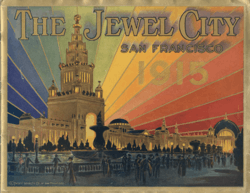
Buildings from the Exposition that still stand today (other than the Palace of Fine Arts) include what is now called the Bill Graham Civic Auditorium at Civic Center Plaza and the Japanese Tea house, which was barged down the Bay to Belmont, California and currently operates as a restaurant.
Also surviving are the one-third scale steam locomotives of the Overfair Railroad that operated at the Exposition. They are maintained in working order at the Swanton Pacific Railroad Society located on Cal Poly San Luis Obispo's Swanton Ranch just north of Santa Cruz.[21][22]
The Legion of Honor Museum, in Lincoln Park, was the gift of Alma de Bretteville Spreckels, wife of the sugar magnate and thoroughbred racehorse owner/breeder Adolph B. Spreckels.[23] The building is a full-scale replica of the French Pavilion from the 1915 Panama Pacific International Exposition, which in turn was a three-quarter-scale version of the Palais de la Légion d'Honneur also known as the Hôtel de Salm in Paris by George Applegarth and H. Guillaume. At the close of the exposition, the French government granted Spreckels permission to construct a permanent replica of the French Pavilion, but World War I delayed the groundbreaking until 1921.[24]
The warehouse for the exposition is located at Fort Hunter Liggett in South Monterey County and has served as the base fire department for the last 30 years. Prior to that it served as a gym, PX and a movie theater for the base. Prior to that it served as a barn.
Commemorations

The US Post Office issued a set of four postage stamps to commemorate the exposition, with designs depicting a profile of Vasco Núñez de Balboa (1¢), the Pedro Miguel Locks of the Panama Canal (2¢), the Golden Gate (5¢), and the discovery of San Francisco Bay (10¢). The stamps were first put on sale in 1913, to promote the coming event, and perforated 12, and then reissued in 1914 and 1915, perforated 10. Their prices today range widely; the 2¢ of 1913 is available for under a dollar in used condition, while an unused 10¢ of the scarcer orange-yellow variety in 1915 can be worth up to a thousand United States dollars.[25]
The United States Congress authorized the San Francisco Mint (also known as "The Granite Lady") to issue a series of five commemorative coins. Said coins were the 1915-S silver Panama-Pacific half dollar and four gold coins. The denominations of the gold coins were $1, $2 1⁄2 (quarter eagle) and $50 (in two types: a round coin, and an unusual octagonal coin). The Panama-Pacific coins have the distinction of being the first commemorative coins to bear the motto "In God We Trust", and were also the first commemoratives to be struck at a branch mint.[26] The two lower denomination gold coins are scarce, while the two $50 ones are extremely rare. The silver half dollar had a mintage of 27,134 and in modestly worn condition is available for several hundred dollars.
Numismatist Farran Zerbe supervised the creation of a series of commemorative medals, an award medal, a souvenir medal, and diplomas.[27]
In 2015, the California Historical Society, the Maybeck Foundation, and Innovation Hangar will partner with the City and County of San Francisco to commemorate the centennial of the transformative 1915 Panama Pacific International Exposition.[28]
On June 20, 2015 a commemorative orchestra, chorus and band concert was held at the Palace of Fine Arts to celebrate the 100th anniversary of the fair.
A feature film, When the World Came to San Francisco, which tells the story of the fair, was made by writer and director R. Christian Anderson. It was part of the city's official centennial celebration sanctioned by the California Historical Society. The film had its world premiere at the de Young Fine Arts Museum in Golden Gate Park on October 30, 2015.[29]
Gallery
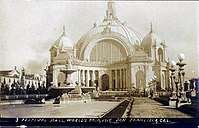 Festival Hall
Festival Hall Tower of Jewels at night
Tower of Jewels at night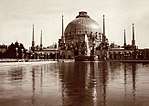 Palace of Horticulture
Palace of Horticulture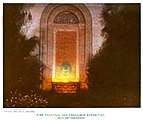 San Francisco, autochrome color photo (1916)
San Francisco, autochrome color photo (1916)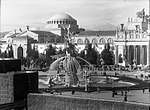 Fountain of Energy
Fountain of Energy California Building
California Building The model of the Panama Canal
The model of the Panama Canal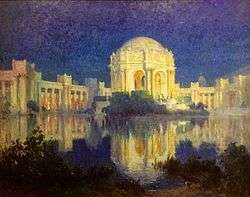 Palace of Fine Arts, by Exposition exhibitor Colin Campbell Cooper
Palace of Fine Arts, by Exposition exhibitor Colin Campbell Cooper.jpg) The State of Wisconsin Pavilion
The State of Wisconsin Pavilion The "India Block" at the Exposition.
The "India Block" at the Exposition.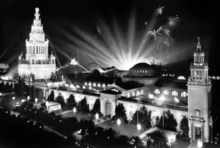 Floodlit pavilion at the Panama–Pacific International Exposition. The Tower of Jewels on the left, and the Italian Tower on the right
Floodlit pavilion at the Panama–Pacific International Exposition. The Tower of Jewels on the left, and the Italian Tower on the right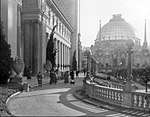 The Court of Palms, with the Palace of Horticulture at background
The Court of Palms, with the Palace of Horticulture at background General view with the Palace of Horticulture (left) and Tower of Jewels (right)
General view with the Palace of Horticulture (left) and Tower of Jewels (right) Aerial view of the Panama–Pacific International Exposition. The exposition buildings have been colored to distinguish them from the rest of the Marina District area.
Aerial view of the Panama–Pacific International Exposition. The exposition buildings have been colored to distinguish them from the rest of the Marina District area. Modern picture of the Palace of Fine Arts, the only building surviving today (reconstructed) still on the exposition grounds
Modern picture of the Palace of Fine Arts, the only building surviving today (reconstructed) still on the exposition grounds
See also
- The Tower of Jewels
- The Pioneer, a sculpture by Solon Borglum that debuted at the exposition
- Mabel and Fatty Viewing the World's Fair at San Francisco
- "Lines on "The Muse Finding the Head of Orpheus" by John E. D. Trask
- Golden Gate International Exposition (1939-40 SF World's Fair)
- List of world expositions
- List of world's fairs
Footnotes
- "Liberty Bell Attracts Crowd in Greenville During 1915 Stop". Greenville Advocate. July 3, 2007.
- Nye, Doug (1978). The United States Grand Prix and Grand Prize Races, 1908-1977. Garden City, NY: Doubleday. pp. 32–33. ISBN 978-0-385-14203-8.CS1 maint: ref=harv (link)
- "Brochure for the Panama-Pacific International Exposition". Smithsonian Institution Archives. Retrieved 25 May 2012.
- http://www.boyar.cn/article/2009/11/05/255803.shtml 1911年鱼面作为云梦名产参加巴拿马举行的万国博览会,以“银丝鱼面”获银质奖。
- http://www.yunmengnet.com/zt/dmpczl1/201706/t20170605_84781.shtml 百年前的1915年,云梦鱼面就在巴拿马万国博览会上荣获银质奖;
- Markwyn, Abigail. “Beyond The End of the Trail: Indians at San Francisco’s 1915 World’s Fair.” Ethnohistory, vol. 63, no. 2, Apr. 2016, pp. 273–300. EBSCOhost, doi:10.1215/00141801-3455299.
- Munro, Lisa. “Investigating World’s Fairs: An Historiography.” Studies in Latin American Popular Culture, vol. 28, Jan. 2010, pp. 80–94. EBSCOhost, doi:10.1353/sla.0.000
- Munro, Lisa. “Investigating World’s Fairs: An Historiography.” Studies in Latin American Popular Culture, vol. 28, Jan. 2010, pp. 80–94. EBSCOhost, doi:10.1353/sla.0.000
- Markwyn, Abigail. “Beyond The End of the Trail: Indians at San Francisco’s 1915 World’s Fair.” Ethnohistory, vol. 63, no. 2, Apr. 2016, pp. 273–300. EBSCOhost, doi:10.1215/00141801-3455299.
- Munro, Lisa. “Investigating World’s Fairs: An Historiography.” Studies in Latin American Popular Culture, vol. 28, Jan. 2010, pp. 80–94. EBSCOhost, doi:10.1353/sla.0.000
- Munro, Lisa. “Investigating World’s Fairs: An Historiography.” Studies in Latin American Popular Culture, vol. 28, Jan. 2010, pp. 80–94. EBSCOhost, doi:10.1353/sla.0.000
- Krasniewicz, Louise. “All the World in One Place.” Expedition, vol. 57, no. 1, Spring 2015, pp. 7–13. EBSCOhost, search.ebscohost.com/login.aspx?direct=true&db=a9h&AN=102888163&site=ehost-live.
- Markwyn, Abilgail M. “Queen of the Joy Zone Meets Hercules: Gendering Imperial California at the Panama-Pacific International Exposition.” Western Historical Quarterly, vol. 47, no. 1, Spring 2016, pp. 51–72. EBSCOhost, doi:10.1093/whq/whv039
- Markwyn, Abigail M. “Queen of the Joy Zone Meets Hercules: Gendering Imperial California at the Panama-Pacific International Exposition.” Western Historical Quarterly, vol. 47, no. 1, Spring 2016, pp. 51–72. EBSCOhost, doi:10.1093/whq/whv039
- Markwyn, Abigail M. “Queen of the Joy Zone Meets Hercules: Gendering Imperial California at the Panama-Pacific International Exposition.” Western Historical Quarterly, vol. 47, no. 1, Spring 2016, pp. 51–72. EBSCOhost, doi:10.1093/whq/whv039.
- Markwyn, Abigail M. “Queen of the Joy Zone Meets Hercules: Gendering Imperial California at the Panama-Pacific International Exposition.” Western Historical Quarterly, vol. 47, no. 1, Spring 2016, pp. 51–72. EBSCOhost, doi:10.1093/whq/whv039.
- Markwyn, Abigail M. “Queen of the Joy Zone Meets Hercules: Gendering Imperial California at the Panama-Pacific International Exposition.” Western Historical Quarterly, vol. 47, no. 1, Spring 2016, pp. 51–72. EBSCOhost, doi:10.1093/whq/whv039.
- “The Pioneer Mother’s Monument—What it Should Be,” San Francisco Call , 26 June 1914 and Frink, “Pioneer Mother Monument,” 103–4
- Simpson, Problems Women Solved , 148, 151; and “Motherhood Monument to be dedicated to Pioneer Mothers,” folder 11, box 52, San Francisco Misc/Ephemera Oversize Pamphlets Relating to the Panama-Pacific International Exposition, Panama-Pacific International Exposition Company Papers, California Historical Society, San Francisco.
- McCoy, Esther (1960). Five California Architects. New York: Reinhold Publishing Corporation. p. 6. ASIN B000I3Z52W.
- "Swanton Pacific Railroad Society".
- "Swanton Pacific Railroad Facebook Page".
- "About ArtPoint". Archived from the original on 2008-06-25. Retrieved 2008-12-12.
- "History of the Legion of Honor | Legion of Honor".
- "Auction Sale 1040 — Outstanding United States Stamps".
- "1915 Panama Pacific Exposition Coinage". www.pdxcoinclub.org. Archived from the original on 2015-09-24. Retrieved 2007-08-17.
- "Panama-Pacific Expo 5 Coin Set on exhibit at Santa Clara Expo : Coin Collecting News". www.coinlink.com. Retrieved 2017-06-05.
- "Home - Panama-Pacific International Exposition". Panama-Pacific International Exposition.
- When the World Came to San Francisco, ppie100.org
Further reading
- Laura A. Ackley, "San Francisco's Jewel City: The Panama-Pacific International Exposition of 1915." Berkeley, CA: Heyday, 2014.
- Lee Bruno, "Panorama: Tales from San Francisco's 1915 Pan-Pacific International Exposition." Petaluma, CA: Cameron+Company, 2014.
- Abigail M. Markwyn, "Empress San Francisco: The Pacific Rim, the Great West, and California at the Panama-Pacific International Exposition." Lincoln, NE: University of Nebraska Press, 2014.
- Sarah J. Moore, Empire on Display: San Francisco's Panama-Pacific International Exposition of 1915. Norman, OK: University of Oklahoma Press, 2013.
External links
| Wikimedia Commons has media related to Panama-Pacific International Exposition. |
- Official website of the BIE
- Historical photography of the Panama Pacific International Exposition
- JB Monaco Panama Pacific International Exposition Photo Gallery
- The Panama-Pacific International Exposition at San Francisco, 1915 (1915). From Internet Archive.
- Panama-Pacific International Exposition, San Francisco, 1915 (1914) From Internet Archive
- Catalogue de luxe of the Department of Fine Arts, Panama-Pacific International Exposition From Internet Archive
- Panama-Pacific International Exposition AND mediatype:movies From Internet Archive.
- The Panama Pacific International Exposition, from San Francisco Memories
- Panama-Pacific International Exposition Map — 1915, from the Virtual Museum of the City of San Francisco
- Virtual Tour of the Panama Pacific International Exposition from the History Center at the San Francisco Public Library
- Panama-Pacific International Exposition photographic collections, via Calisphere
- Swanton Pacific Railroad Society at Cal Poly San Luis Obispo' Swanton Pacific Ranch
- California Digital Library Guide to the Panama Pacific International Exposition Records at The Bancroft Library
- Books about the Exposition at Project Gutenberg
- June 20, 2015 Centennial Concert at Palace of Fine Arts
- Camille Saint-Saens Hail! California written for and premiered at the Panama–Pacific International Exposition
- Photograph Album of the Panama-Pacific International Exposition at the Newberry Library
